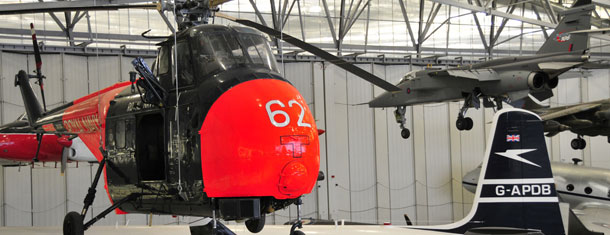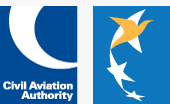
Hayward Aviation Safety Seminar
The Hayward Aviation Safety Seminar for Helicopter Club members attracted a gratifying total of 90 people, and all of us should be safer for the experience if we absorbed the wisdom on offer.
Held in the Conference Centre in the new Airspace Hangar at Duxford, which houses aircraft as diverse as the York, Comet, and Concorde, the seminar coincided with Helitech, allowing the members to go on to the show after lunch, which was generously laid on by Hayward Aviation, Europe's largest helicopter insurance brokers with some 83 percent of the market.
The Seminar was opened by our chairman John Matchett, who briefly introduced the two speakers, Matthew Day and Richard Mornington-Sanford. Matthew Day is a director of Haywards, which was set up in 1992 with one client – Bristows – and has become the third largest such company in the world. Richard Mornington-Sanford is Robinson Helicopters' international air accident investigator and is a former RAF engineer, flying instructor and examiner.
Hayward Aviation Ltd have supported the Helicopter Club in many ways and for many years, and their directors Guy Holland Bosworth, Ian Rubie and Matthew Day are regular visitors to Club events. But as Matthew Day said at the Safety Seminar, for some time they've wanted to do more than just ask for our premiums once a year – they've wanted to make a positive move to reduce risk. An insurance premium is an investment you hope will never pay off. Making a claim means that somebody, somewhere has failed – sometimes a manufacturer, sometimes an engineer, but overwhelmingly more often, a pilot.
Insurers would much rather take your premiums and not pay out, as Matthew Day stressed. Equally, Club members would much rather pay their premiums and not need to call on the services of Hayward Aviation Ltd – but unfortunately, it happens. "Our business is risk," Matthew said. "I'm not a pilot, and helicopter aerodynamics are beyond my grasp, but I know how insurers view risk. And right now, the market is hard, and it is tightening. We must balance the income from premiums with outgoings, and it's unpredictable – you can do well for ten years, then one accident can wipe you out. The recent Air France accident (off the Brazilian coast) looks likely to cost underwriters somewhere in the region of £1.5 billion."
In the past, he said, some claims had been paid out even if not all the terms and conditions of the policy had been met, but given the current state of the market, underwriters are being much less flexible. "Insurers are not making money and there is less flexibility now if the terms are broken," Matthew said. "Always be sure to fly within the conditions laid out in your policy."
Many members were baffled by the apparently random appearance of a slide of a group of zebras during Matthew's presentation, along with a flimsy connection revolving around things that looked the same but weren't. In fact, a photograph had been taken of Matthew in a hot tub at the German Championships, and he really didn't like it – you'd know why if you saw it. When he asked how he could prevent this photograph finding its way into Rotor Torque Matthew was told that unless he could somehow work zebras into his safety presentation, the picture would be published. One tenuous connection later, and he was off the hook. Pity.
He was, Matthew said, merely the warm-up act for the main event, accident investigator (and long-time Club member) Richard Mornington Sanford.
Those who know Richard will be aware that he is a sensitive man who is deeply affected by what he sees at accident sites, and whose reflections on the folly of pilots come from the heart. The carnage lives with him every day, as does the long, long aftermath of an accident – the tragedy of broken lives, the shattered families, the shock and misery of bereavement. "When you take a passenger flying, you assume an awesome responsibility," he says. "The wreckage of an aircraft is the wreckage of families, and of people's lives.Your family, and your passengers' families – you leave a dreadful legacy..."
Richard began by reviewing helicopter accidents over the past three years. "The vast majority were caused by bad decision-making before take-off and could easily have been prevented," he said. AR44 accident in Lanarkshire in which the pilot, having expressed worries about bad visibility, took off in fog and crashed into a tree. A Twin Squirrel that crashed in bad weather, at night, killing four people. An R44 that crashed near Kendal in Cumbria after running into bad visibility – four dead. A Single Squirrel that crashed in Lanarkshire when the pilot seemed hell-bent on showing his passengers 'a good time'; four dead, two of them aged five and six years. There were more.
Richard showed a rich selection of accident photographs, all of them tactfully avoiding displaying the remains of the human factor which led to the accident in the first place. "This is a dangerous activity," he said. "In terms of risk, riding a motorcycle comes close. But it's not the helicopter that causes the accident – the helicopter is a benign object. It's the pilot. It's you. You make the decisions, you check the paperwork, you sign the tech log as commander. It's your finger on the trigger."
One of the goals of PPL training, he went on, is to instil confidence in the pilot. There is, however, a serious risk of over confidence, a factor which crops up regularly in the accident statistics.
Richard mentioned an R44 accident in Glencoe where a pilot had taken off into bad weather and gathering darkness, assuring an engineer who was worried about anybody's ability to fly a small helicopter in such conditions, 'It's okay, I have a night rating'. The pilot, Richard said, seemed to consider the rating to be some sort of talisman that would ward off disaster. "He's learned at night, he's done his instrument familiarisation, he's passed the test, he's shown he's able to do a 180 and recover from unusual attitudes – it had all given him enormous confidence. Too much, in fact. "Look at the accident reports.
It's very easy to sit there in a warm room with a cup of coffee and think, what a bloody idiot, there's no way I'd have done that…but the pilot didn't set out to commit suicide. It all made perfect sense to the pilot at the time." Is some PPL training causing them to believe their skills are better than they are? Richard posed the question, and Vic Nash answered by inveighing against the five hours' instrument training now incorporated into the PPL(H) on the instructions of the JAA. If you teach people to fly on instruments, test them on their skill and certify that they are able to fly on instruments, you are instilling a false confidence in them which is proving deadly. Richard agreed wholeheartedly, saying there has been a 20 percent increase in IMC accidents since the requirement was introduced. "As an instructor I have always refused to teach it," Richard said. "I will not be party to something that encourages people to think they can get away with flying in IMC. It should be removed from the syllabus, and replaced with a module designed to teach people how to make a precautionary landing."
One of Richard's slides showed an R44 which crashed in a Russian forest after the drunken pilot decided he was going off to shoot wolves from his helicopter. Another is a well-worn photograph taken from the back seat of a Bell 206 of a pilot who had blundered into IMC and was about to crash, killing all on board. "Stress levels like this cannot be simulated," Richard said. "Everyday tasks become difficult, if dominated by autorotation, and thus the biggest perceived risk is engine
failure.We pay lip service to the other risks. But engine failure is very rare. In all my years as an investigator for Robinson around the world, I've never once been to an accident site where the engine was the cause of the accident. "On the other hand I've been to a lot of accident sites where over reaction to a relatively benign indication in the cockpit has been the cause. Over-reaction is a far bigger killer than engine failure.We are trained to have a hair-trigger reaction to a perceived engine problem, to throw it at the ground – that's what we teach people to do."
Richard put up a picture of a written off R44 which got water in the pitot-static system, causing a loss of airspeed indication. The pilot's instant reaction was to autorotate, and he got into vortex ring and crashed. Richard showed video of another R44 crashing after getting into vortex ring as it approached a rooftop in Jakarta. The aircraft slid across the roof and dynamically rolled over, tumbling off the building and plunging 26 storeys into a swimming pool, killing all on board. "The pilot had just got into the aircraft and made the approach," said Richard. "There was no recce, no plan – he could have gone round either side of the building but was fixated on making the landing.
Can you teach judgement? There should be more human performance training in the PPL syllabus." Richard posited four attitudes which are often displayed by pilots heading for accidents: 1. Antiauthority. "I have that, in spades," he said. 2. Impulsivity. "That's me through and through." 3. A feeling of invulnerability. "I don't have that – that's what helps to keep me out of trouble." 4. Macho. "Macho is my middle name. But I recognise my vulnerability, and that is the saving grace. Every pilot should reflect on just how vulnerable he or she is in a helicopter, and make decisions accordingly."
More than 40 helicopter graced the static display at Helitech
The rotary-wing sector remains relatively buoyant despite the economic downturn, with more than 4,000 industry visitors
going throughthe doors at Helitech 2009. The figure represented an 11 percent increase on 2007.The biennial show, which is the biggest helicopter expo outside America, attracted more than 200 exhibitors from 21 countries and has 42 aircraft in the static display.
A number of significant aircraft and equipment orders were announced at the show. Agusta Westland and the Bristow Group signed an agreement for three AW139 medium twin engine helicopters to be used for offshore transport operations. The deal includes options for additional AW139 purchases by Bristows.
Rolls-Royce signed an exclusive distribution agreement with AAR for aftermarket supply of RR300 parts and services – this is the engine Frank Robinson is putting in the R66. Eurocopter announced an order for a new EC135 for the West Midlands Police Air Support Unit, and there were a number of big-ticket announcements in the air ambulance sector.
Sue Bradshaw, the event's Exhibition Director, said:"Helitech 2009 far exceeded expectations, and people in the industry know it is all about capitalising on a route into the sector for all levels of the rotary supply chain. It's also about catching up with customers and contacts."
One of the high-profile visitors to the expo was Sergei Sikorsky, son of Igor, who presented a cheque for $38,000 to the RAF Museum to go with the Sikorsky MH-53 helicopter the company has donated to the museum. For those whose forward planning goes beyond the middle of next week, Helitech 2011 will be held at Duxford from 27-29 September.
back to articles page →